Shingles, also known as herpes zoster, is a condition caused by the reactivation of the varicella-zoster virus (VZV)—the same virus responsible for chickenpox. Adults, particularly those who have had chickenpox in childhood, are at risk of developing shingles later in life. This article delves into the relationship between chickenpox exposure and the occurrence of shingles in adults, addressing key questions about the virus, its transmission, risk factors, symptoms, prevention, and treatment.
Understanding Varicella-Zoster Virus (VZV)
The varicella-zoster virus belongs to the herpesvirus family and is highly contagious. It spreads primarily through respiratory droplets or direct contact with the fluid from chickenpox blisters. Once a person contracts chickenpox, the virus remains dormant in the body’s nerve tissues, specifically in the dorsal root ganglia near the spinal cord and brain.
Shingles and Its Connection to Chickenpox
Pathophysiology of Shingles
Shingles occurs when the dormant VZV reactivates, traveling along the nerve fibers to the skin. This reactivation can happen decades after the initial chickenpox infection. The exact mechanisms triggering this reactivation are not entirely understood, but they are believed to be related to a decline in VZV-specific immunity.
Risk Factors for Shingles
Several factors increase the likelihood of developing shingles, including:
- Age: The risk of shingles increases with age, particularly after 50 years.
- Weakened Immune System: Conditions like HIV/AIDS, cancer, and treatments such as chemotherapy and steroids can compromise the immune system, heightening the risk.
- Stress: High stress levels can weaken the immune system, potentially triggering VZV reactivation.
- Previous Chickenpox Infection: Adults who had chickenpox as children are more susceptible, as the virus remains dormant in their nerve cells.
Can Adults Get Shingles from Chickenpox Exposure?
Exposure to Chickenpox vs. Shingles Development
Adults cannot contract shingles directly from someone with chickenpox or shingles. Instead, exposure to chickenpox can cause chickenpox in someone who has never had it. Once infected with chickenpox, the individual then has the potential to develop shingles later in life.
Reactivation of VZV
Shingles results from the reactivation of the virus already present in a person’s body, not from new exposure to VZV. Therefore, an adult who has previously had chickenpox may develop shingles due to internal factors like weakened immunity rather than direct exposure to an individual with chickenpox.
SEE ALSO: Does the Shingrix Vaccine Make You Sick?
Symptoms and Complications of Shingles
Typical Symptoms
Shingles often starts with pain, itching, or tingling in a specific area on one side of the body or face, followed by the appearance of a red rash. This rash evolves into painful blisters that scab over in 7 to 10 days and typically clear up within 2 to 4 weeks. Common symptoms include:
- Pain: Often severe and localized, it can precede the rash by days.
- Rash: A stripe of blisters on one side of the body or face.
- Fever and Chills: Mild to moderate fever and general malaise.
Complications
Shingles can lead to several complications, especially in older adults:
- Postherpetic Neuralgia (PHN): Persistent nerve pain in the area where the rash occurred, lasting long after the rash has healed.
- Vision Loss: If shingles involve the eye (ophthalmic shingles), it can result in painful eye infections and potential vision loss.
- Neurological Problems: Depending on the nerves affected, shingles can cause encephalitis, facial paralysis, or hearing problems.
- Skin Infections: Bacterial infections of the blisters can occur if not properly managed.
Prevention and Vaccination
Chickenpox and Shingles Vaccines
Two vaccines are crucial in the context of VZV:
- Varicella Vaccine: Administered to children to prevent chickenpox.
- Shingles Vaccine (Shingrix): Recommended for adults over 50 or those with weakened immune systems to prevent shingles and its complications.
Efficacy and Recommendations
The shingles vaccine has been shown to be highly effective in reducing the incidence of shingles and postherpetic neuralgia. The Centers for Disease Control and Prevention (CDC) recommends two doses of the Shingrix vaccine for adults over 50, even for those who have had shingles before.
Treatment of Shingles
Antiviral Medications
Prompt treatment with antiviral drugs, such as acyclovir, valacyclovir, or famciclovir, can reduce the severity and duration of shingles if started within 72 hours of the rash onset. These medications work by inhibiting viral replication.
Pain Management
Pain from shingles can be intense and debilitating. Treatment options include:
- Analgesics: Over-the-counter pain relievers like acetaminophen or ibuprofen.
- Nerve Blockers: Prescription medications such as gabapentin or pregabalin.
- Topical Agents: Lidocaine patches or capsaicin cream.
Preventing Complications
Managing shingles effectively involves not only treating the virus and alleviating pain but also preventing secondary bacterial infections. Keeping the rash clean and dry and applying antibiotic ointments as needed can help prevent skin infections.
Living with Shingles
Coping Strategies
Living with shingles can be challenging due to the pain and potential complications. Coping strategies include:
- Healthy Lifestyle: Maintaining a healthy diet, regular exercise, and adequate sleep to support the immune system.
- Stress Management: Techniques such as meditation, yoga, and deep-breathing exercises can help reduce stress levels.
- Support Networks: Joining support groups for individuals with shingles or chronic pain conditions can provide emotional support and practical advice.
Conclusion
Shingles is a significant health concern for adults, especially those who have had chickenpox in childhood. Understanding the relationship between chickenpox and shingles, recognizing the symptoms, and knowing the risk factors are crucial steps in managing and preventing this condition. Vaccination remains the most effective way to prevent shingles and its complications, highlighting the importance of public health initiatives in promoting vaccination among older adults. Early treatment and comprehensive management strategies can mitigate the impact of shingles, improving the quality of life for those affected. By staying informed and proactive, individuals can better navigate the challenges associated with shingles and maintain their overall health and well-being.
Related Topics:



























